

Domestic System. Sinn Fein. Fabian Society. The Communist Party of Great Britain. On 31st July, 1920, a group of revolutionary socialists attended a meeting at the Cannon Street Hotel in London.
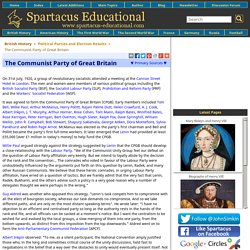
The men and women were members of various political groups including the British Socialist Party (BSP), the Socialist Labour Party (SLP), Prohibition and Reform Party (PRP) and the Workers' Socialist Federation (WSF). It was agreed to form the Communist Party of Great Britain (CPGB). Early members included Tom Bell, Willie Paul, Arthur McManus, Harry Pollitt, Rajani Palme Dutt, Helen Crawfurd, A. J. Cook, Albert Inkpin, J. Independent Labour Party. Lib-Lab MPs. Lib-Lab MPs. Social Democratic Federation. The Liberal Party. Chartist Party. The Conservative Party. The Tories. The Whigs. House of Lords. Kings in the Middle Ages would often consult their tenants-in-chief before making important decisions.

These men were usually called to appear before the king during religious festivals (Christmas, Easter, Whitsun). Some of the men who attended these meetings were given specific jobs to perform for the king, for example, to act as treasurer. House of Commons. In 1275 Edward I called a meeting of Parliament (parler was Norman French for talk).
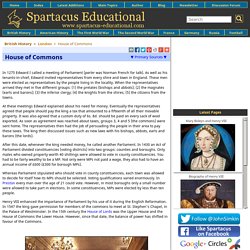
As well as his tenants-in-chief, Edward invited representatives from every shire and town in England. These men were elected as representatives by the people living in the locality. When the representatives arrived they met in five different groups: (1) the prelates (bishops and abbots); (2) the magnates (earls and barons); (3) the inferior clergy; (4) the knights from the shires; (5) the citizens from the towns. At these meetings Edward explained about his need for money. Eventually the representatives agreed that people should pay the king a tax that amounted to a fifteenth of all their movable property. After this date, whenever the king needed money, he called another Parliament. Whereas Parliament stipulated who should vote in county constituencies, each town was allowed to decide for itself how its MPs should be selected.
The Jacobite Rebellion. A Jacobite was a supporter of the exiled royal house of the Stuart.

The Jacobites took their name from Jacobus, the Latin name for James II, who had been deprived of his throne in 1688. In 1743 war broke out between England and France. As France was a Catholic nation, it had always supported the Stuarts' claim to the English throne. King Louis XV realised that it would be in his interests if the Stuarts made another attempt to regain the throne. Louis XV informed James Edward Stuart in 1745 that if he invaded England he would supply him with arms and ammunition.
Once in Scotland, Charles Stuart, who had been nicknamed Bonnie Prince Charlie, began building up his army. King Charles II and the Catholic Church. In 1665 England became involved in a war with Holland.
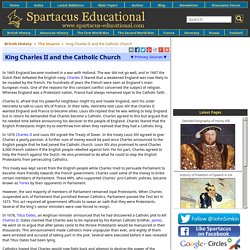
The war did not go well, and in 1667 the Dutch fleet defeated the English navy. Charles II feared that a weakened England was now likely to be invaded by the French. For hundreds of years the French were seen as England's main European rivals. One of the reasons for this constant conflict concerned the subject of religion. Whereas England was a Protestant nation, France had always remained loyal to the Catholic faith. Charles II, afraid that his powerful neighbour might try and invade England, sent his sister Henrietta to talk to Louis XIV of France. Anglicans. When Elizabeth replaced Mary as queen, she re-established Protestantism as England's official religion.
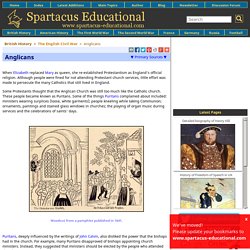
Although people were fined for not attending Protestant church services, little effort was made to persecute the many Catholics that still lived in England. Some Protestants thought that the Anglican Church was still too much like the Catholic church. These people became known as Puritans. Some of the things Puritans complained about included: ministers wearing surplices (loose, white garments); people kneeling while taking Communion; ornaments, paintings and stained glass windows in churches; the playing of organ music during services and the celebrations of saints' days. Timeline of the Early British Kingdoms 599 AD-937 AD.
Timeline of Anglo Saxon England 597 AD-687 AD. 597 - The Roman brand of Christianity is brought to Britain for the first time by St.

Augustine, the missionary sent from Pope Gregory to convert the Saxons. Augustine lands in Kent and is welcomed by King Aethelbert whose Frankish Queen is already a Christian practicing at her church of St. Martin's, Canterbury. Augustine converts Aethelbert and his court to Christianity and founds a monastery at Canterbury. Timeline of Medieval Britain. Edward the Confessor. William the Conqueror. William, the illegitimate son of Robert, Duke of Normandy and Herleva of Falaise, was born in 1027.
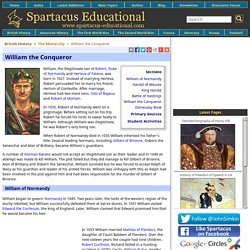
Instead of marrying Herleva, Robert persuaded her to marry his friend, Herluin of Conteville. After marriage, Herleva had two more sons, Odo of Bayeux and Robert of Mortain. In 1035, Robert of Normandy went on a pilgrimage. Before setting out on his trip Robert he forced his lords to swear fealty to William. Although William was illegitimate, he was Robert's only living son. When Robert of Normandy died in 1035 William inherited his father's title. A number of Norman barons would not accept an illegitimate son as their leader and in 1040 an attempt was made to kill William. King William II (William Rufus) William Rufus (the Red), the second surviving son of William the Conqueror and Matilda of Flanders, was born in about 1056.
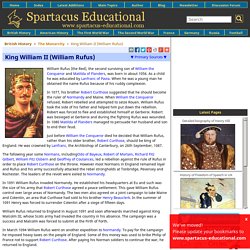
As a child he was educated by Lanfranc of Pavia. Battle of Hastings. King Henry I.